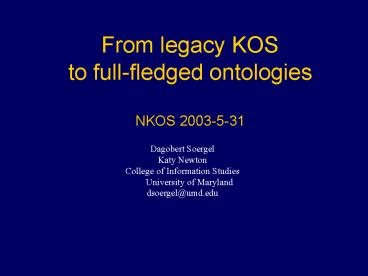From legacy KOS to fullfledged ontologies NKOS 2003531 PowerPoint PPT Presentation
Title: From legacy KOS to fullfledged ontologies NKOS 2003531
1
From legacy KOS to full-fledged ontologiesNKOS
2003-5-31
Dagobert Soergel Katy Newton College of
Information StudiesUniversity of
Maryland dsoergel_at_umd.edu
2
The problem
- AI and Semantic Web applications need
full-fledged ontologies that support reasoning - Constructing such ontologies is expensive
- While existing KOS do not provide the full set of
precise concept relationships needed for
reasoning,existing KOS, both large and small,
represent much intellectual capital - How can this intellectual capital be put to use
in constructing full-fledged KOS - Paper gives some examples and points for
discussion
3
Steps in convertinga legacy KOS
- Define the ontology structure
- Fill in values from one or more legacy KOSto the
extent possible - Edit manually using an ontology editor
- make existing information more precise
- add new information
4
Pioneer MedIndex by Susanne Humphrey
- Defined ontology structure through frames
- Created preliminary frame hierarchy by importing
the MeSH hierarchy - Used own ontology editor to
- enter slot fillers (some based on Related Term
relationships) and - refine hierarchical inheritance specifications
5
Example 1
- Assume the rules
- Rule 1If X isa (type of) instruction and X has
domain Zand Y isa ability and Y has domain
ZThen X should consider Y - Rule 2If X should consider Yand Y is supported
by WThen X should consider W
6
Example 1, continued
ERIC Thesaurus entries Reading instructionBT
InstructionRT ReadingRT Learning
standards Reading abilityBT AbilityRT
ReadingRT Perception
7
Example 1, continued
To apply the rules, we need Reading
instruction isa InstructionReading
instruction has domain ReadingReading
instruction governed by Learning
standards Reading ability isa AbilityReading
ability has domain ReadingReading
ability supported by Perception
8
Example 2
- In MeSH (Medical Subject Headings, NLM)
- Hierarchical relationships are isa relationships
- Except, in the Anatomy section hierarchical
relationships are part of relationships - Discovering such regularities can save a lot of
manual editing
9
The Semantic Code
Perry, J.W. and Kent, A. Tools for Machine
Literature Searching. New York Interscience
Publishers 1958 There are some old systems that
are close to full-fledged ontologies Can be
expressed in RDF or OWL
10
Semantic code
11
Semantic code examples
Windshield, A part of a vehicle that is composed
of ceramic or glass and is used for
protection. Semantic code cerm hicl putt ce
ramic intrinsic vehicle inclusive protection
productive
12
Semantic code examples
Dip needleA device that is influenced by
magnetism to be used as an indicator. Semantic
code mach mqgn nudc device
categorical magnetaffective indicatorproductive
13
Semantic code examples
ModernizationA process that produces an
alteration, characterized by time Semantic
code tymm cung pass time
attributive alteration productive process
categorical
14
Semantic code examples
Seal Shares properties with fish. Semantic
code fzsh fish simulative
15
Semantic code
16
Semantic code class hierarchy
ltowlversionInfogt1.0lt/owlversionInfogtlt/owlOntol
ogygt ltowlClass rdfID"GeneralConcepts"gt
ltrdfslabelgt1 General Conceptslt/rdfslabelgtlt/owl
Classgt ltowlClass rdfID"Forces"gt
ltrdfslabelgt1.5 Forceslt/rdfslabelgt
ltrdfssubClassOf rdfresource"GeneralConcepts"/gt
lt/owlClassgt ltowlClass rdfID"Magnet"gt
ltrdfslabelgtMagnet m-gnlt/rdfslabelgt
ltrdfssubClassOf rdfresource"GeneralizedSubstanc
es" /gt ltrdfssubClassOf rdfresource"Properties
InvolvingStates" /gt ltrdfssubClassOf
rdfresource"Forces"/gt lt/owlClassgt
17
Semantic code examples
ltowlObjectProperty rdfID"categorical"gt
ltrdfscommentgtis alt/rdfscommentgt
ltrdfslabelgtcategorical Alt/rdfslabelgt
ltrdftype rdfresource"owlTransitiveProperty"
/gt lt/owlObjectPropertygt ltowlObjectProperty
rdfID"simulative"gt ltrdfscommentgtshares
properties with (but is not an instance
of)lt/rdfscommentgt ltrdfslabelgtsimulative
Zlt/rdfslabelgt ltrdftype rdfresource"owlSymme
tricProperty" /gt lt/owlObjectPropertygt
18
Semantic code examples
ltrdfDescription rdfabout"windshield"gt
ltinclusive rdfresource"perry1.owlVehicle"/gt
ltintrinsic rdfresource"perry1.owlCeramicOrGlass
"/gt ltproductive rdfresource"perry1.owlProtect
ion"/gt lt/rdfDescriptiongt
19
Semantic code examples
ltrdfDescription rdfabout"dipNeedle"gt
ltaffective rdfresource"perry1.owlMagnet"/gt
ltcategorical rdfresource"perry1.owlDevice"/gt
ltproductive rdfresource"/perry1.owlIndicator"/gt
lt/rdfDescriptiongt ltrdfDescription
rdfabout"seal"gt ltsimulative
rdfresource"perry1.owlFish"/gt lt/rdfDescription
gt
20
Semantic code inference
Inference Fish shares properties with
seal. Rationale Seal is defined by a simulative
relationship with fish. In the ontology, the
simulative relationship is defined as a
symmetrical property. If A is in a simulative
relationship with B, then B is in a simulative
relationship with A. Judgment Good inference.
21
Semantic code inference
Inference A dip needle is a child of the class,
product. Rationale A dip needle is an instance
of a device. Device is a subclass of
product. Judgment Good inference.
22
Not much use of KOS for AI ontology development
- Most ontology development in the AI community
appears to start from scratch - In the medical world many people start from UMLS
23
Conclusion
- Dont reinvent the wheel, improve it
- Discussion

